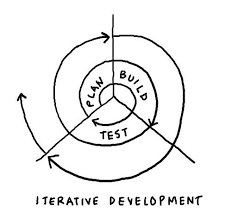The way we consume information has changed a lot over the last 20 years.
There's no need to save up for an expensive set of encyclopedia and search its pages, now that we can find almost anything online. And usually, we can access it from the phones in our pockets.

Now, the challenge is navigating a world of information overload.
Rumie's answer to this challenge: Bytes.
Bytes are concise micro-learning experiences that meet the evolving needs of modern learners.
Why micro-learning?
Breaking complex topics down into bite-sized chunks can actually improve learner retention by up to 20%. (1)
Think about it this way: even textbooks are broken down into chapters and subsections. They use headers and formatting to visually direct learners. And rarely would someone tackle a whole textbook at once.
By breaking information down into short, focused bytes, we can reduce the cognitive load on learners and empower them to really absorb the material. We serve one bite at a time, instead of an entire 3 course meal.
 (1) Kapp, F., Proske, A., Narciss, S., & K?rndle, H. (2015). Distributing vs. Blocking Learning Questions in a Web-Based Learning Environment. Journal of Educational Computing Research, 51(4), 397?416.
(1) Kapp, F., Proske, A., Narciss, S., & K?rndle, H. (2015). Distributing vs. Blocking Learning Questions in a Web-Based Learning Environment. Journal of Educational Computing Research, 51(4), 397?416.
Learning Doesn't Exist in a Vacuum
Our standards for online learning are now influenced by all the other digital media we consume, from Tiktok to instagram.
Our attention spans have shrunk as our expectations have grown.
Learners expect sleek interfaces with intuitive navigation. They also expect multimedia engagement and to have their attention captured immediately.
Bytes deliver on this by incorporating multimedia elements and through a clean, consistent interface. Pictures, audio, video, and interactive questions hold learners' attention while meeting design standards that ensure learners will give the platform a slice of their sought after attention.
Did you know?
Engaging the Affective Domain
While online articles can transmit information through the cognitive domain, stagnant content fails to engage our affective domain.
The affective domain goes beyond the 'facts' of what we're learning, and engages our social and emotional side.

Bytes transmit information to engage us cognitively, and use multiple choice questions and a takeaway prompt to engage the affective domain. For example, questions invite the learner to make a decision, pushing them to respond instead of just remembering. Effective takeaway prompts also encourage the learner to connect their new findings with real application, extending learning even after they finish a byte.
Quiz
Why don't articles engage our affective domain?
Subscribe for more quick bites of learning delivered to your inbox.
Unsubscribe anytime. No spam. 🙂
Fueled by Data
The beauty of Bytes is that they allow us to capture a wealth of data related to learner behaviours. So we can make targeted recommendations for learners in the same way that Netflix, Youtube, or Amazon do.

What learners spend time on, the content categories that get the most traction, and where they lose interest, all help to inform a system of iterative improvements.
The result? A medium that meets the needs of modern learners and gets better over time.
Summary
By watching, listening, and adapting, we create valuable learning experiences that align with the needs and expectations of modern learners.
As you continue with your week, consider the online learning materials you consume.
Are they focused and digestible?
Are they multimedia rich?
Do they engage you in decision making?
Are they informed by data?
If you find any gaps, it means there's an opportunity to use Bytes for better learning.

Your feedback matters to us.
Do you feel like you + Articulate the purpose of Bytes.?
New Bytes
We publish fresh Bytes daily, we can send you a notification when that happens.